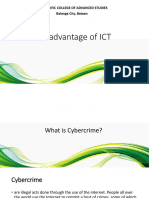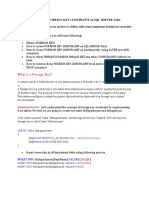0 ratings0% found this document useful (0 votes)
33 viewsLearning Python From Scratch To Building and Deploying
Uploaded by
Bandari GaneshCopyright
© © All Rights Reserved
We take content rights seriously. If you suspect this is your content, claim it here.
Available Formats
Download as PDF, TXT or read online on Scribd
0 ratings0% found this document useful (0 votes)
33 viewsLearning Python From Scratch To Building and Deploying
Uploaded by
Bandari GaneshCopyright
© © All Rights Reserved
We take content rights seriously. If you suspect this is your content, claim it here.
Available Formats
Download as PDF, TXT or read online on Scribd
You are on page 1/ 3
Here’s a step-by-step guide to learning Python from scratch to building and deploying a full-fledged
web application:
Step 1: Learn Python Basics
1. Syntax & Basic Concepts
Variables, data types (int, float, string, list, tuple, dict, etc.)
Control structures (if-else, loops)
Functions and arguments
Exception handling
File handling
2. Object-Oriented Programming (OOP) in Python
Classes and objects
Methods and attributes
Inheritance, polymorphism, encapsulation
Constructors and destructors
3. Python Standard Libraries
Math, datetime, random, itertools, functools, etc.
4. Practice Simple Projects
Create small projects like a calculator, to-do list, or basic text-based games to solidify basics.
Step 2: Learn Intermediate Python Concepts
1. Advanced Data Structures
Sets, dictionaries, list comprehensions, generators
2. Functional Programming
Lambda functions, map, filter, reduce
3. Modules and Packages
Importing and creating modules and packages
4. Working with APIs
Learn how to use APIs with libraries like requests
Example: Fetch data from a public API (e.g., weather data)
5. Regular Expressions
Pattern matching with the re module
6. Database Handling
Learn SQL and how to integrate with Python using libraries like sqlite3 or SQLAlchemy
7. Testing & Debugging
Writing unit tests using unittest or pytest
Debugging with tools like pdb
Step 3: Learn Web Development with Python
1. Learn the Basics of Web Development
HTML, CSS, JavaScript (basic level) to understand front-end development.
2. Learn a Web Framework: Flask or Django
Flask: Lightweight, flexible web framework (better for learning)
Routing, templates, static files, request and response handling
Django: Full-fledged framework with built-in admin, ORM, authentication
Follow the MVC (Model-View-Controller) architecture
3. Building a Web App
Simple app with Flask or Django (e.g., a blog, a task manager)
Work with templates, forms, static files, and databases
CRUD operations: Create, Read, Update, Delete with a database
Step 4: Learn Database Management
1. SQL Basics
Learn SQL queries, joins, and aggregations
Integrate Python with databases like PostgreSQL, MySQL, or SQLite
2. ORM (Object Relational Mapper)
Learn Django ORM or SQLAlchemy to handle database operations in a Pythonic way.
Step 5: Learn Frontend Development (Basic)
1. HTML/CSS
Building static layouts
2. JavaScript Basics
Handling basic user interactions (e.g., form submissions, page navigation)
3. Frontend Libraries
Use simple frontend frameworks/libraries like Bootstrap to style your app.
4. Learn a Frontend Framework (optional but useful)
React.js or Vue.js if you want to build a modern frontend.
Step 6: Learn API Development (RESTful Services)
1. REST API Basics
Learn about HTTP methods (GET, POST, PUT, DELETE)
Status codes, request/response cycle
2. Building REST APIs
Using Flask or Django Rest Framework (DRF)
Handle routes, authentication (JWT/OAuth), and data serialization
3. Testing APIs
Test APIs using Postman or Curl
Step 7: User Authentication & Authorization
1. Authentication
Implement user sign-up, login, logout functionality
Use libraries like Flask-Login, Django-Auth, or OAuth
2. Authorization
Role-based access control (admin, user)
Secure routes and data access
Step 8: Work with Third-Party Services
1. Cloud Integration
Integrate cloud services like AWS (S3 for storage, SES for email) or Google Cloud
2. Use External APIs
Payment gateways (Stripe, PayPal), social media integration, etc.
Step 9: Learn Deployment and DevOps
1. Version Control with Git
Learn Git for version control, branching, merging
Use GitHub or GitLab for hosting your code
2. Environment Management
Virtual environments (using virtualenv or pipenv )
Managing dependencies ( requirements.txt or Pipfile )
3. Containerization with Docker
Build Docker images and run your app in containers for easy deployment
4. Cloud Platforms for Deployment
Heroku: Simple cloud platform for Python apps
AWS/Google Cloud/Azure: Deploy using services like EC2, Elastic Beanstalk, or App Engine
5. CI/CD Pipelines
Automate deployment with services like GitHub Actions, CircleCI, or TravisCI.
6. Web Server Setup
Use Gunicorn (for WSGI) or Nginx to serve your app in production
Step 10: Advanced Topics (Optional but Useful)
1. Security Best Practices
Learn about SQL injection, XSS, CSRF, and how to prevent them
Secure sensitive data (passwords, tokens) using encryption
2. Performance Optimization
Caching strategies (Redis, Memcached)
Optimize database queries, minimize resource usage
3. Scalability
Load balancing, microservices architecture, container orchestration with Kubernetes.
Step 11: Final Project & Continuous Learning
1. Build a Full Stack Web Application
Combine frontend and backend to create a full-fledged web app
Example: E-commerce platform, social media site, or SaaS product
2. Continue Learning
Explore advanced topics like machine learning, data science, or AI
Stay updated with new technologies, frameworks, and trends
This roadmap will give you the skills to develop and deploy a full-fledged, scalable, and secure Python
web application.
You might also like
- Learn Python and Develop A Full Deployable Android App or Web AppNo ratings yetLearn Python and Develop A Full Deployable Android App or Web App3 pages
- Becoming a full-stack developer with Python involves mastering both front-_20241230_120127_0000No ratings yetBecoming a full-stack developer with Python involves mastering both front-_20241230_120127_000023 pages
- How to Become a Good Python with Flask developerNo ratings yetHow to Become a Good Python with Flask developer8 pages
- how to be full stack developer .... using pythonNo ratings yethow to be full stack developer .... using python2 pages
- EdYoda - Python Django Developer ProgramNo ratings yetEdYoda - Python Django Developer Program15 pages
- how to be full stack developer .... using python option2No ratings yethow to be full stack developer .... using python option23 pages
- Django 2.2 & Python: The Ultimate Web Development Bootcamp: Build three complete websites, learn back and front-end web development, and publish your site online with DigitalOcean. Alam - Download the full ebook set with all chapters in PDF format100% (1)Django 2.2 & Python: The Ultimate Web Development Bootcamp: Build three complete websites, learn back and front-end web development, and publish your site online with DigitalOcean. Alam - Download the full ebook set with all chapters in PDF format57 pages
- Django 2.2 & Python: The Ultimate Web Development Bootcamp: Build three complete websites, learn back and front-end web development, and publish your site online with DigitalOcean. Alam instant downloadNo ratings yetDjango 2.2 & Python: The Ultimate Web Development Bootcamp: Build three complete websites, learn back and front-end web development, and publish your site online with DigitalOcean. Alam instant download61 pages
- EdYoda Python Developer Program CurriculumNo ratings yetEdYoda Python Developer Program Curriculum10 pages
- An ultimate guide to web development in Python _ BrowserStackNo ratings yetAn ultimate guide to web development in Python _ BrowserStack18 pages
- 7 Beginner To Python Pro - Your Guide On How To Become A Python Developer - TAKEONo ratings yet7 Beginner To Python Pro - Your Guide On How To Become A Python Developer - TAKEO3 pages
- Udacity Enterprise Syllabus Full Stack Web Developer Nd0044No ratings yetUdacity Enterprise Syllabus Full Stack Web Developer Nd004417 pages
- What Are The Key Elements One Must Know Before Starting To Learn Full Stack With DjangoNo ratings yetWhat Are The Key Elements One Must Know Before Starting To Learn Full Stack With Django8 pages
- Python Full Stack With Djando and PostgreSQLNo ratings yetPython Full Stack With Djando and PostgreSQL2 pages
- Python_Full_Stack_Development_PresentationNo ratings yetPython_Full_Stack_Development_Presentation10 pages
- Leanpub - Tango.with - Django.B01N91N65Y YFURWS2No ratings yetLeanpub - Tango.with - Django.B01N91N65Y YFURWS2276 pages
- Django 2.2 & Python: The Ultimate Web Development Bootcamp: Build three complete websites, learn back and front-end web development, and publish your site online with DigitalOcean. Alam pdf download100% (2)Django 2.2 & Python: The Ultimate Web Development Bootcamp: Build three complete websites, learn back and front-end web development, and publish your site online with DigitalOcean. Alam pdf download58 pages
- The Ultimate Django Guide: From Beginner to Advanced Web DevelopmentFrom EverandThe Ultimate Django Guide: From Beginner to Advanced Web DevelopmentNo ratings yet
- EmpoweringFutures8WeekPythonFullStackInternship6f6425ad339a83dbNo ratings yetEmpoweringFutures8WeekPythonFullStackInternship6f6425ad339a83db13 pages
- The Oracle Universal Content Management Handbook: Build, administer, and manage Oracle Stellent UCM SolutionsFrom EverandThe Oracle Universal Content Management Handbook: Build, administer, and manage Oracle Stellent UCM Solutions5/5 (1)
- [Ebooks PDF] download Django 2.2 & Python: The Ultimate Web Development Bootcamp: Build three complete websites, learn back and front-end web development, and publish your site online with DigitalOcean. Alam full chapters100% (3)[Ebooks PDF] download Django 2.2 & Python: The Ultimate Web Development Bootcamp: Build three complete websites, learn back and front-end web development, and publish your site online with DigitalOcean. Alam full chapters51 pages
- B.I.T.S. Pilani, M. Tech. Software Systems SOFTWARE ARCHITECTURES (ZG653) - Assignment 1No ratings yetB.I.T.S. Pilani, M. Tech. Software Systems SOFTWARE ARCHITECTURES (ZG653) - Assignment 15 pages
- Software Release Notes - Fieldconnex Advanced Diagnostic Software CollectionNo ratings yetSoftware Release Notes - Fieldconnex Advanced Diagnostic Software Collection1 page
- If The Autoplay Window Appears, Click The Close Button.No ratings yetIf The Autoplay Window Appears, Click The Close Button.3 pages
- BCom General Computer Applications Semester IIINo ratings yetBCom General Computer Applications Semester III10 pages
- Shinetech CV - Senior Software Engineer - Kris WangNo ratings yetShinetech CV - Senior Software Engineer - Kris Wang5 pages
- FANUC Series 16i 18i 21i-TATB Direct Input of Offset Value Measured B For 2 Spindle LatheNo ratings yetFANUC Series 16i 18i 21i-TATB Direct Input of Offset Value Measured B For 2 Spindle Lathe14 pages
- PMS Integration and Energy Management Dashboard - StruxureWare Building Operation - Specification SheetNo ratings yetPMS Integration and Energy Management Dashboard - StruxureWare Building Operation - Specification Sheet4 pages
- Create, Check and Drop FOREIGN KEY CONSTRAINT On SQL SERVER TableNo ratings yetCreate, Check and Drop FOREIGN KEY CONSTRAINT On SQL SERVER Table8 pages
- The Internet and The Word Wide Web Topic 1: Origin of The Internet and EvolutionNo ratings yetThe Internet and The Word Wide Web Topic 1: Origin of The Internet and Evolution11 pages
- 1500 Michael Waidson - IPShowcase-KeepingTimePTP-Tektronix-NAB 2019No ratings yet1500 Michael Waidson - IPShowcase-KeepingTimePTP-Tektronix-NAB 201918 pages
- REST Web Services Using Integrated SOA GatewayNo ratings yetREST Web Services Using Integrated SOA Gateway14 pages

























































































